At Outbuilders, we’ve seen a growing interest in tiny homes as an alternative living solution. These compact dwellings offer a unique lifestyle that’s catching the attention of many.
In this post, we’ll explore the benefits and drawbacks of living in a tiny home. From financial savings to potential legal hurdles, we’ll cover what you need to know before downsizing.
What Are Tiny Homes?
Defining Tiny Living Spaces
Tiny homes are compact dwellings that typically measure around 170 square feet. These mini homes are the size of a single room, built in a mirror-image plan of the bedroom and kitchen. The tiny house movement has experienced a remarkable 67% growth since 2010, driven by financial considerations, environmental awareness, and a desire for simpler living.
The Financial Appeal
Affordability stands as a primary motivator behind the tiny home trend. In 2023, the average cost of a traditional home in the United States reached $428,700. Tiny homes offer a budget-friendly alternative, with the National Association of Home Builders reporting an average cost between $30,000 and $60,000 (making homeownership accessible to a wider demographic).
Environmental Benefits
Tiny homes attract individuals concerned about their ecological footprint. Research indicates that tiny homes appear more energy efficient and have on average only 60% of the energy consumption per capita compared to standard houses. This reduction translates to substantial utility savings, with some tiny homeowners reporting up to 80% lower monthly costs compared to traditional homes.
Types of Tiny Homes
The tiny home market presents various options to accommodate different needs and preferences:
- On-wheels tiny homes: These mobile units provide flexibility and often fall under RV classification, facilitating easier zoning compliance in certain areas.
- Container homes: Repurposed shipping containers serve as sturdy and eco-friendly foundations for compact living spaces.
- Prefab tiny homes: These pre-manufactured units allow for quick on-site assembly, reducing construction time and expenses.
- Converted sheds and cabins: Some companies (like Outbuilders) offer storage sheds and cabins that customers adapt for compact living arrangements.
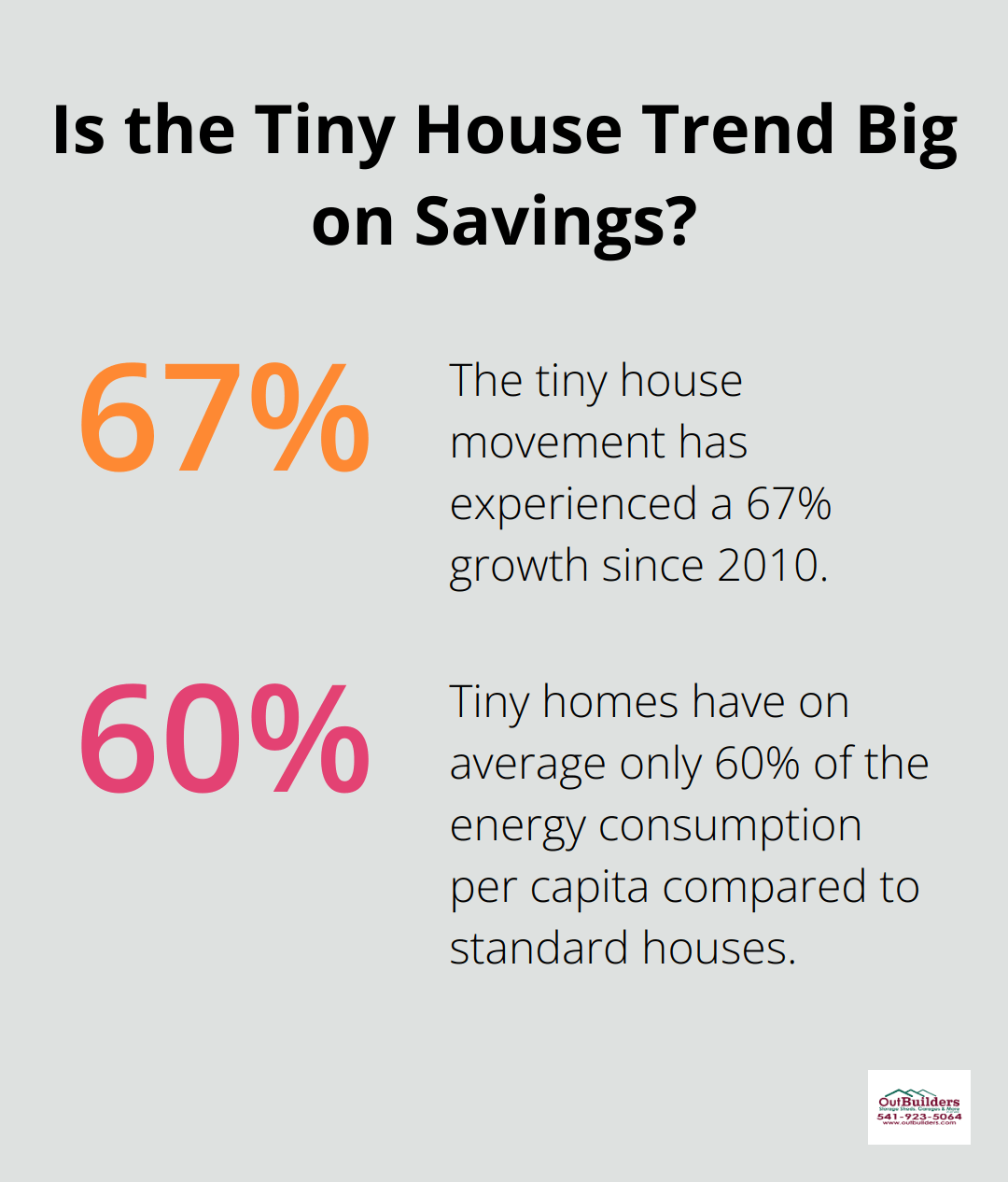
As the tiny home movement continues to gain momentum, it challenges traditional notions of housing and prompts a reevaluation of living space requirements. The next section will explore the advantages of embracing this minimalist lifestyle.
Why Tiny Homes Make Sense
Financial Freedom Through Downsizing
Tiny homes slash living costs dramatically. The average price of a tiny home is $67,000, which is 87% cheaper than the average price of a normal-sized house. This stark difference allows many to own their homes outright, eliminating mortgage payments.
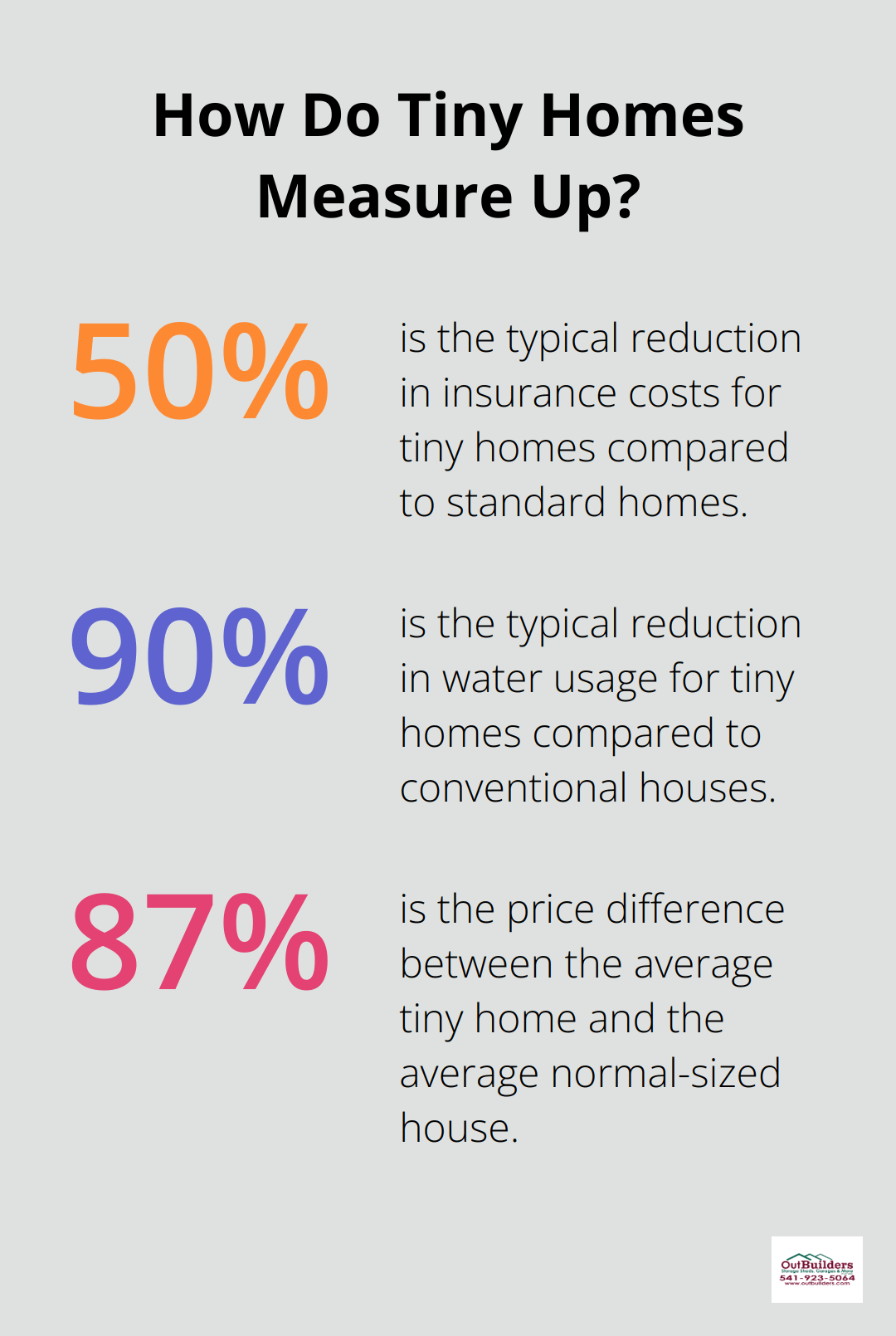
Monthly expenses plummet too. Tiny homeowners report utility bills as low as $25 per month (compared to the national average of $117 for electricity alone). Insurance costs typically drop by 50% compared to standard homes. These savings enable residents to allocate more funds towards experiences, travel, or investments.
Eco-Friendly Living Made Easy
Tiny homes excel in sustainability. Their small footprint translates to reduced energy consumption – about 7% of what a traditional home uses. This efficiency stems from smaller spaces to heat and cool, coupled with energy-efficient appliances designed for compact living.
Water usage in tiny homes typically drops by 90% compared to conventional houses. Many tiny homeowners incorporate rainwater collection systems and composting toilets, further minimizing their environmental impact. The construction of a tiny home also uses fewer materials, reducing waste and resource consumption.
Embracing Minimalism and Clarity
The limited space in a tiny home naturally promotes a minimalist lifestyle. This isn’t just about owning fewer possessions; it’s about curating a life filled with items that truly matter. Many tiny home dwellers report reduced stress levels and improved mental clarity after downsizing.
Organization becomes key in a tiny home. Every item must earn its place, leading to creative storage solutions and multi-functional furniture. This intentional approach to possessions often extends into other areas of life, promoting mindfulness and purposeful living.
Flexibility and Adventure on Your Terms
Tiny homes, especially those on wheels, offer unparalleled flexibility. Whether you chase job opportunities or seek new scenery, your home can come along. This mobility appeals particularly to digital nomads and retirees who want to explore without being tied to a specific location.
Some tiny home communities even offer the option to rent out your space when you’re away, providing an additional income stream. This flexibility extends to placement options – from RV parks to private land, tiny homes adapt to various settings.
While the tiny home lifestyle presents numerous benefits, it’s important to consider potential challenges as well. The next section will explore some of the drawbacks and obstacles that tiny home dwellers might face.
The Hidden Challenges of Tiny Home Living
Space Constraints: More Than Just Downsizing
The most obvious challenge of tiny home living is the limited space. With an average size of 170 square feet, every inch counts. This constraint forces residents to make tough decisions about what to keep and what to discard.
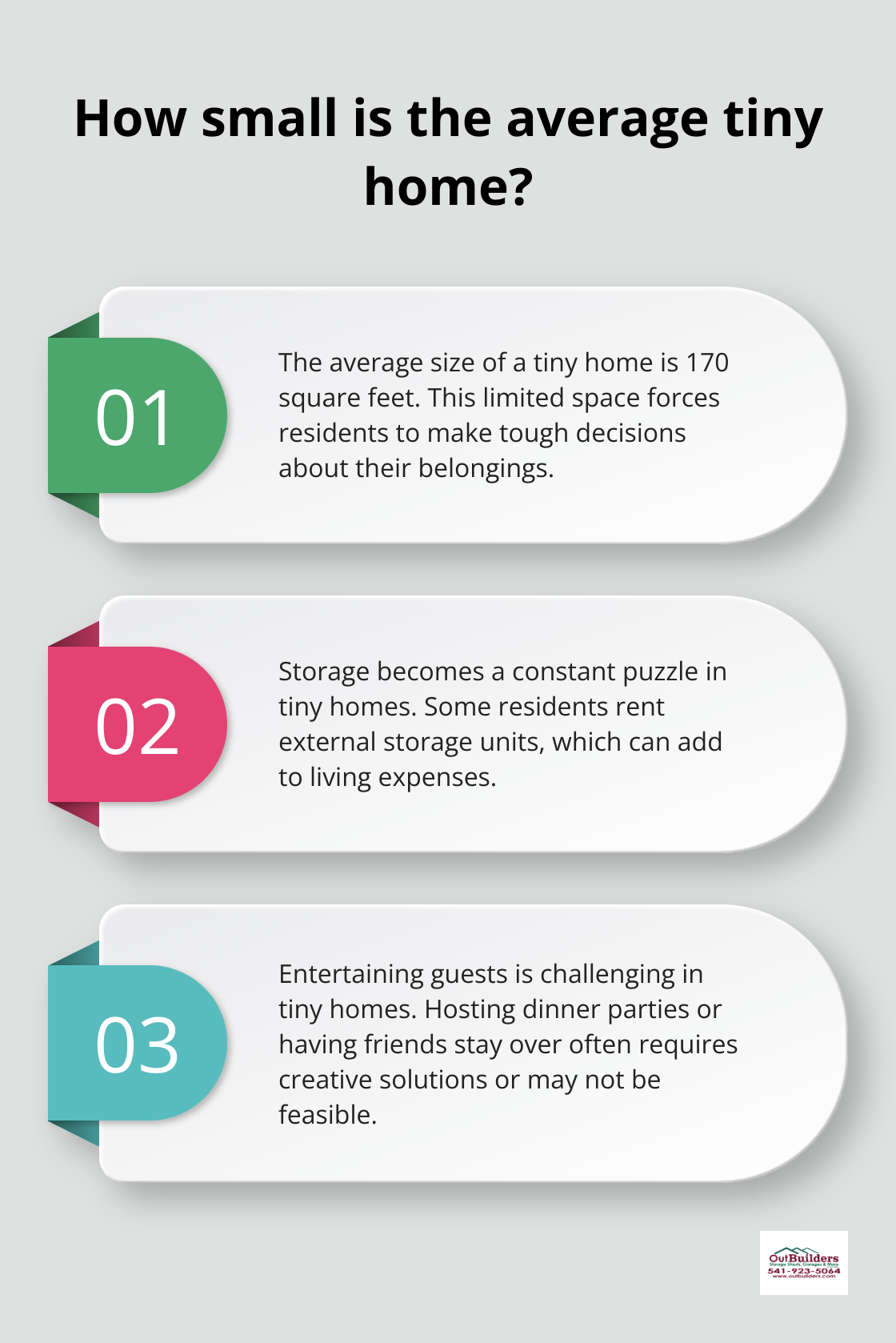
Storage becomes a constant puzzle. Many tiny homeowners spend hours planning and reorganizing their belongings. Some rent external storage units, which can add to living expenses.
Entertaining guests becomes a logistical challenge. Hosting dinner parties or having friends stay over often requires creative solutions or simply isn’t feasible. This can lead to feelings of social isolation for some tiny home dwellers.
Legal Hurdles: Navigating a Complex Landscape
Zoning laws and building codes pose significant obstacles for tiny home enthusiasts. Legal hurdles vary significantly from state to state. In California, stringent zoning laws and building codes restrict tiny house placements.
Parking a tiny home on wheels can be equally challenging. RV parks often have stay limits, and many cities prohibit long-term RV living on private property. This leaves tiny homeowners in a legal gray area, constantly searching for places to park legally.
Resale Woes: A Niche Market
Selling a tiny home can be more difficult than a traditional house. The market for these unique dwellings is still relatively small, limiting the pool of potential buyers.
Additionally, tiny homes often depreciate in value, similar to RVs. While tiny homes are generally cheaper than traditional houses, costs associated with them can still stack up.
Financing can also be a challenge for both buyers and sellers. Many banks don’t offer traditional mortgages for tiny homes, especially those on wheels. This can limit financing options and make it harder to find qualified buyers.
Lifestyle Adjustments: Not for Everyone
The tiny home lifestyle requires significant adjustments that not everyone is prepared for. Privacy becomes a luxury in such close quarters, especially for couples or families. The lack of personal space can strain relationships and lead to increased stress.
Basic tasks like laundry and food preparation become more complicated. Many tiny homes lack full-sized appliances, forcing residents to use laundromats or communal facilities. Cooking elaborate meals can be challenging with limited counter space and small ovens.
Climate control is another concern. Tiny homes can heat up quickly in summer and lose heat rapidly in winter. This can lead to uncomfortable living conditions and higher energy bills, despite the smaller space.
Living in a tiny home comes with its own set of unique challenges that potential owners should carefully consider before making the leap.
Final Thoughts
Living in a tiny home offers benefits and drawbacks that potential dwellers must carefully consider. The financial freedom and environmental advantages are significant, but space constraints and legal hurdles present real challenges. Those interested in this lifestyle should assess their goals and adaptability before making a commitment.
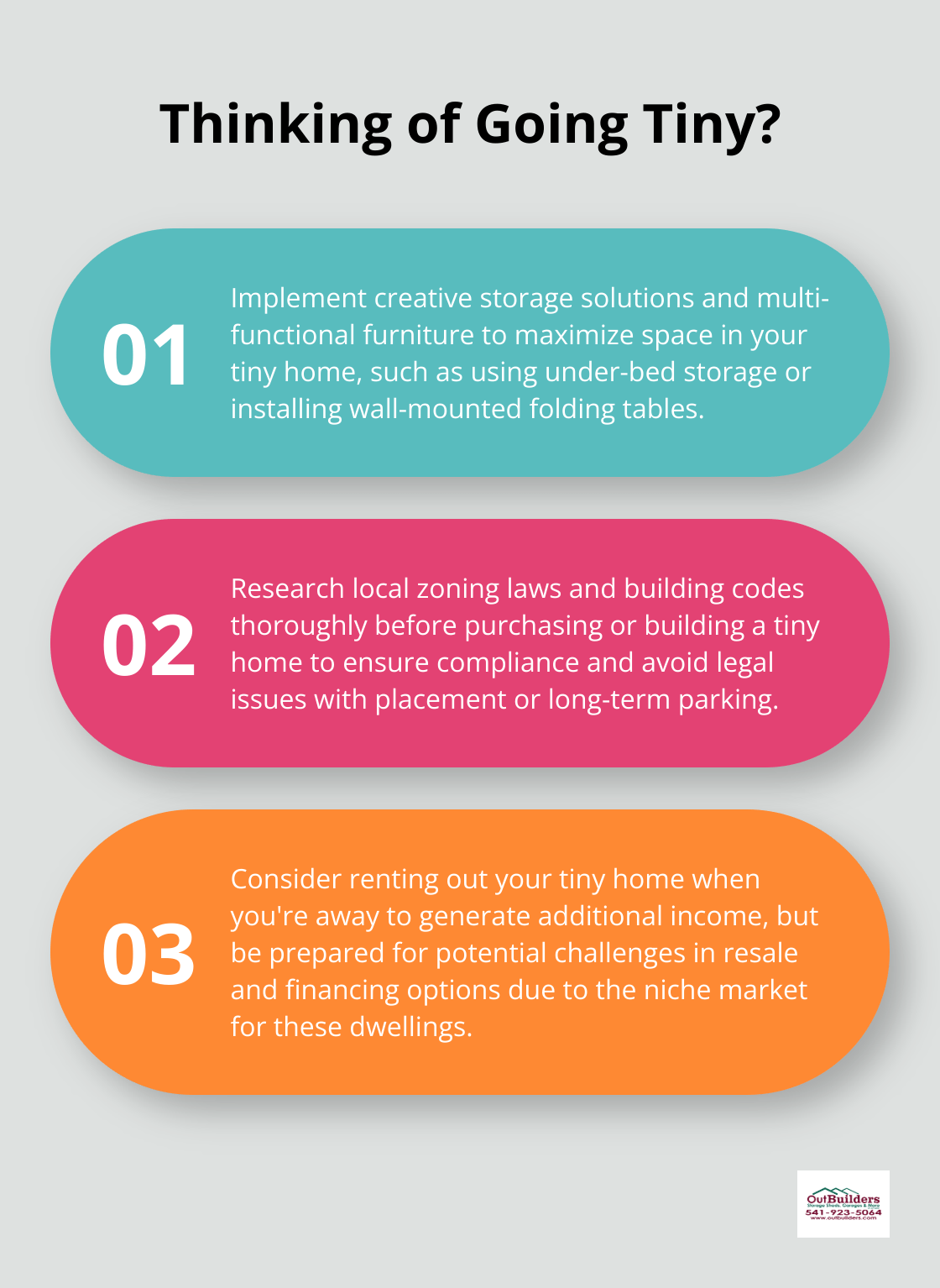
The tiny home movement will likely continue to grow as urban areas become more crowded and housing costs rise. Innovations in design and technology may address some current challenges, making tiny homes a viable option for more people. Outbuilders provides customizable storage sheds and cabins that can be adapted for tiny home living in Central Oregon.
The decision to live in a tiny home is personal and requires understanding both advantages and challenges. This lifestyle can align with values of minimalism and financial freedom (while challenging traditional notions of home). Potential tiny home dwellers should weigh these factors to make an informed choice that suits their preferences and goals.

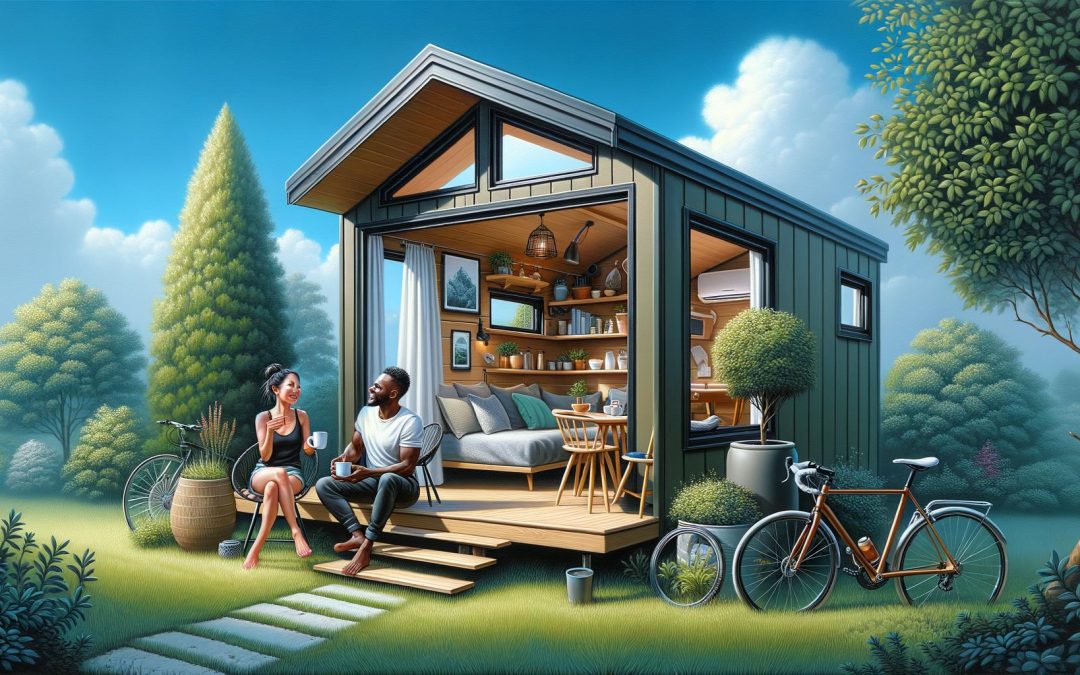





Recent Comments